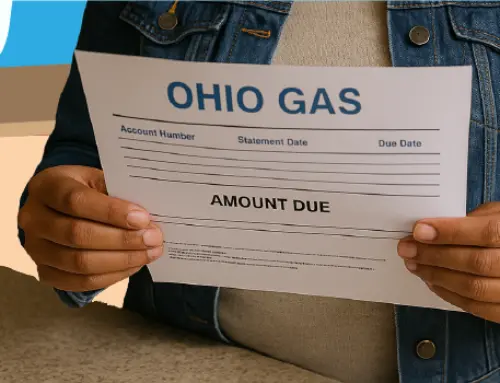Tankless Water Heaters Pros and Cons
by Tyler Castle
11.5 min read
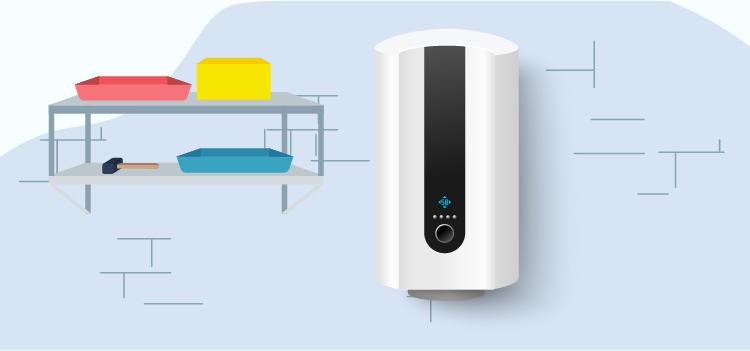
Tankless water heaters, also known as on-demand water heaters, are becoming an increasingly popular choice for homeowners seeking efficient solutions to their hot water needs. But are tankless hot water heaters all their cracked up to be? Are you considering making the switch to a tankless hot water heater? We’ll explore the tankless water heater pros and cons to ensure you’re making the right decision for your home.
Key Points of This Article:
- Tankless water heaters heat water on demand using sensors and temperature controls to deliver consistent hot water.
- They offer major benefits such as higher energy efficiency, endless hot water, space savings, lower risk of leaks, and potential cost incentives.
- Drawbacks include higher upfront installation costs, limited flow rates during simultaneous use, possible need for multiple units, and lack of operation during power outages.
- Choosing and installing a tankless system requires considering household hot water demand, available space, existing plumbing or electrical capacity, and proper professional installation.
What is a tankless water heater?
Tankless models heat water only when it’s needed without a large tank. Traditional tank-style heaters continuously store and heat a large volume of water in a tank that stores water until you need it.
How does a tankless hot water heater work?
A tankless water works by heating water on-demand with a customized heating mechanism. For example, when a water faucet is turned on, cold water flows through a heat exchanger and depending on which model you have, natural gas or electricity heats the water.
Tankless hot water heaters trigger their hot water heating process when the flow sensor is activated. As a bonus, flow sensors measure the rate of water flow. The sensor then alerts the control unit and activates the machine’s heating elements.
Next, the temperature control ensures that the water is heated to the desired temperature and maintains it consistently. After the user sets its preferred temperature, a thermostat continuously monitors the water temperature. As the water heats up, the thermostat continuously checks the temperature and signals the heating elements to turn off or adjust.
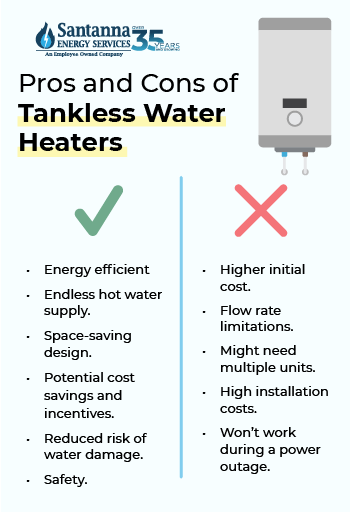
Pros of tankless water heaters
A tankless hot water heater offers several notable advantages that make it an appealing option for homeowners. Here are some of the most notable pros of tankless water heaters:
Energy efficiency
Because tankless water heaters only extract water for on-demand purposes, these units are often praised for their efficiency. For homes that use 41 gallons or less of hot water, tankless water heaters can be 24%–34% more energy efficient than traditional hot water heaters.
Endless hot water supply
Unlike traditional water heaters that store a finite amount of hot water in a tank, tankless models heat water on demand. This means, as long as water is available, it can be heated instantly, allowing for continuous use without running out.
Have you ever heard someone say, “save some hot water for me?” In most cases, traditional tank water heaters can run out of stored hot water leaving for a cold shower if you’re the last in line. With tankless water heaters, these models can ensure that hot water is always available.
Space-saving design
Because of their lack of a storage tank, tankless water heaters are small and great for saving space. Tankless water heaters are especially beneficial in smaller homes or apartments where every square foot counts. When choosing the right tankless heater for your home, be sure to size your unit correctly.
If you choose a model that’s too small, your hot water demand won’t be met. For the complete guide on sizing your tankless water heater, read our blog!
Cost savings and incentives
While the initial investment may be higher than that of a traditional water heater, tankless models are significantly more energy-efficient. According to Ragsdale Heating, Air and Plumbing, using a gas-fired tankless water heater can result in $108 in annual savings while an electric tankless water heater can save you as much as $44.
Many regions can offer certain incentives for homeowners who install energy-efficient appliances like tankless water heaters. These incentives can help offset the upfront costs, making the switch to a tankless system more budget-friendly.
Reduced risk of water damage
One of the most common problems with operating a tank water heater is the risk of a tank rupture or leak. Since most tank water heaters are tucked away in basements or hidden from view, a leak could go unnoticed for some time, increasing the risk of water damage to your home. In contrast, tankless water heaters minimize this risk by heating water on demand and eliminating the need for a large reservoir.
Improved safety
Traditional water heaters with tanks can pose risks such as overheating, pressure buildup, or leaks. This can lead to dangerous situations like scalding, flooding, or even explosions in rare cases. Most modern tankless water heaters are built with a cut-off fuse that prevents the system from overheating. Since tankless water heaters are “tankless”, the risks that are associated with tanks on traditional water heaters won’t be an issue.
Cons of tankless water heaters
Like every appliance, there are various cons to consider. Here are some of the most common disadvantages of owning a tankless water heater:
Higher initial cost
Tankless models typically require a larger upfront investment, not only for the unit itself but also for installation, which may involve upgrading electrical systems or gas lines to meet the heater’s demands. Additionally, installation can be more complex, requiring specialized labor.
Flow rate limitations
Since tankless water heaters heat water on demand, tankless models can struggle to supply hot water to multiple fixtures or appliances simultaneously. For example, running a shower, dishwasher, and washing machine at the same time may exceed the heater’s capacity, resulting in reduced water temperature or insufficient hot water. Issues with flow-rate can be solved by choosing the right size water heater to match your hot water demand.
Potential need for multiple units
If you’re living in a large household with a lot of people, multiple tankless water heaters might be needed. Typically, a household with five people will need a tankless water with a flow rate of seven or more to power multiple fixtures at the same time. But for households of five or more, a second tankless water heater might be needed to ensure all fixtures can be provided with water if they’re all used at the same time.
Installation concerns and costs
According to Home Depot, the average cost for a tankless water heater installation is between $2,400 to $5,400. If you’re looking to install a gas-powered tankless water heater, remember that these units must be connected to house gas lines first which will require a professional. Other factors to consider when installing a tankless water heater include permits, installation materials, installation labor by a local, licensed and insured plumber and removal of your old unit.
Won’t work during a power outage
If your choice of water heater is electric, be aware that your unit won’t work if you’re experiencing a power outage. Traditional tank-style heaters rely on a passive heating method and can often still provide hot water if the power goes out. For households that experience frequent power outages or are in areas prone to such disruptions, this limitation can be a significant inconvenience.
Potential for delayed hot water
A potential drawback of tankless water heaters is the possibility of experiencing a delay in hot water delivery. Since these systems heat water on demand, there can be a lag between turning on a hot water faucet and receiving hot water. This delay can be particularly noticeable in larger homes where the distance between the heater and the tap is significant.
Types of tankless water heaters
Gas Tankless Water Heaters: These units use natural gas and propane to heat water. Gas tankless water heaters need to be connected to gas lines within your home.
Electric Tankless Water Heaters: These heaters use electricity to heat water on demand and are suitable for homes without gas lines.
Non-Condensing Tankless Water Heaters: These operate at a standard efficiency level and expel exhaust gases at higher temperatures.
Condensing Tankless Water Heaters: These models capture and reuse exhaust gases through a heat exchanger, offering improved energy efficiency.
Point-of-Use Tankless Water Heaters: Compact units designed to provide hot water directly at specific fixtures, reducing wait time and energy loss from long pipe runs.
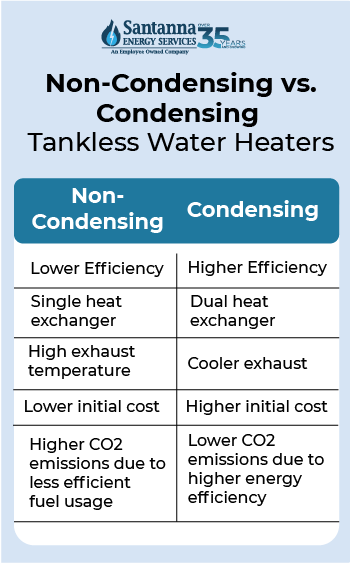
Factors to consider before installing a tankless water heater
If you’re sold on a tankless water heater for your household, consider these factors before you make your final purchase:
Hot water use patterns
Tankless systems are designed to heat water on demand, and their efficiency largely depends on the volume and frequency of hot water usage. If your household has high simultaneous demands, such as multiple showers, appliances, and faucets running at the same time, a tankless water heater may struggle to keep up.
Location and space
Tankless models are compact and can be mounted on walls, which allows for flexible installation in areas with limited space. However, the placement of the unit should be strategically chosen to optimize efficiency and minimize installation costs. For instance, installing the heater close to the points of use can reduce the time and energy required to deliver hot water, while also cutting down on long pipe runs and associated heat loss.
Current water heater system
Transitioning from a traditional tank-style heater to a tankless model often involves significant changes in the home’s plumbing and energy systems. Electric tankless units might necessitate upgrading your electrical system to accommodate the higher power demands. Additionally, the installation process may involve modifying or replacing existing piping to ensure compatibility and optimal performance.
How to install a tankless water heater
The exact installation process of your tankless water heater will vary based on your model and type. Here’s generally how the installion process goes for a gas-powered tankless water heater:
- Call a licensed professional plumber for the job. This can be a very dangerous job if not handled correctly.
- Tankless water heaters require more gas when they fire on than a water heater equipped with a storage tank. You’ll likely have to run a newer, larger gas pipe from your gas meter to feed your new tankless gas water heater. This part of the installation process should definitely be handled by a licensed professional.
- After this is done, remove your old hot water heater. Be sure to turn off your gas and water supply and drain your old water heater. Last, disconnect the gas and water lines from your old model and dispose of your tank. Water tanks can typically be disposed through your local sanitation or a specialized recycling company.
- Mount your new tankless water heater in a proper location of your choosing. Follow the manufacturer’s installation instructions.
- Connect the gas line to the heater location using a threaded black iron pipe. Next, install your gas shut-off valve, tee, and sediment trap to the water heater following the manufacturer’s instructions.
- Next, install new water lines, install a new pressure relief valve, and an exhaust vent.
- Turn on your water and test if everything is working properly.
Maintenance tips for tankless water heaters
Just like any other household device, your water heater can operate at its best with appropriate upkeep! Here are some of our best tips for tankless water heater maintenance:
- Clean the unit periodically to remove mineral buildup, especially in areas with hard water.
- Ensure that the water flow rate meets the manufacturer’s specifications. Low flow can affect performance.
- For gas-powered models, regularly check and clear any blockages in the venting and air intake.
- Some tankless water heaters have filters that should be cleaned or replaced.
- Verify that the temperature settings are accurate and adjust them if necessary.
- Periodically flush the system with a vinegar solution to remove sediment and mineral deposits.
How much does a tankless water heater cost?
According to Forbes, the average cost of tankless water heater is $800. Smaller units can cost as low as $170. The size, type of system, and whether it’s condensing or non-condensing will effect the cost of your model.
Tankless vs tank water heaters
Difference Between Tank and Tankless Water Heaters
| Tankless Water Heater | Tank Water Heater |
|---|---|
| Heats water on demand. | Continuously heats and stores a large volume. |
| Higher initial cost. | Lower initial cost. |
| Lasts at least 20 years. | Lasts 6-12 years. |
| More energy-efficient due to on-demand heating. | Less energy-efficient due to standby heat loss. |
| Compact, wall-mounted design. | Requires floor space for tank storage. |
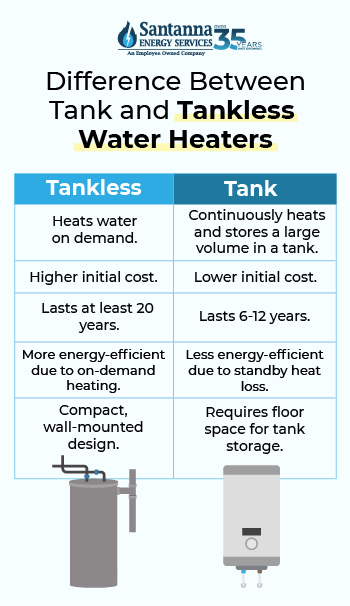
Is a tankless water heater right for you?
Deciding if a tankless water heater is right for you involves evaluating your specific needs and circumstances. Consider a tankless water heater if you have low to medium hot water needs and a smaller household. If you have limited space in your home, a tankless water heater’s compact design is great for fitting in small places. Additionally, if you value energy efficiency and are willing to invest in higher upfront costs for long-term savings, a tankless system might be a good fit.
Assessing these elements will help you determine whether the benefits of a tankless water heater align with your lifestyle and home environment.
There's peace of mind in knowing you'll pay the same monthly supply cost amount for your electricity or natural gas supply without any uncertainty — no matter what. Santanna's Unlimited Energy option protects your bills from fluctuating supply charges no matter the changes in seasons. For over 35 years, Santanna has served customers in Illinois, Indiana, Pennsylvania, Michigan, and Ohio. Our mission is to provide innovative and cost-effective energy solutions that will help our customers achieve their energy goals.
Tyler is an experienced energy professional, having worked for Santanna Energy Services, for the past four years. He is passionate about renewable energy and believes that diversifying the energy grid is the key to a sustainable future. Tyler is dedicated to supplying consumers with the best possible energy solutions and works diligently to make sure that Santanna can deliver the highest quality service.




